| |
Mechanisms
More details on Mechanism design are to be found in the links below the table
|
Introduction A mechanism considered to be an assembly of mechanical items designed to achieve a specific purpose within a machine. There are clearly an infinite number of mechanisms available but the notes and links are concentrating on the specific ones as listed below. For specific information on linkages please refer.. Linkages Motion Control Using Computers The notes below relate generally to mechanical methods for providing relative motion
and forces. There is an increasing tendency to produce motions using servo
hydraulic systems and stepping motors under the control of digital computers.
Although the mechanism design often requires creativity and a high level of analysis the final
product is often low priced and provides reliable, efficient, predictable performance. However a mechanism
is generally made to perform a fixed operation, reliably and predictably. Computer
controlled motions can be continuously monitored and if necessary modified. If the
output motion is changed from a harmonic motion to a periodic square wave motion or a
sawtooth motion then changing the control parameters for a computer controlled system
is often very convenient. If a large number of systems have been developed
then the cost of modifying the software or firmware is much less than modifying a large
number of mechanisms.. Classification Of Mechanisms There are many methods of classifying mechanisms. The following list is a functional list based on the type of motion required. This list is based on that provided in Theory of Machines and Mechanisms ..Uicker, Pennock, ans Shigley. The notes below are low level descriptions. Over time additional notes will be included...For detailed analysis and synthesis please refer to the books listed in the book section of this site. Snap Action Mechanisms Snap action mechanisms are also called toggle and bi-stable mechanism are widely used for components for simple toggle switches to clamps. A typical toggle mechanism is shown below...
Linear Actuators Stationary Screws with rotating nuts Fine adjustment mechanisms A fine adjusting mechanism is primarily used for control where small movements are required resulting from larger movements of the input. The variations of this group include screws, differential screws, gears, cams.etc etc. A typical method of providing small output rotations from input motions is shown below.. One rotation of the input shaft will result in a linear motion of the carriage of 0,5mm..
Clamping Mechanisms Typical clamping mechanisms include toolmakers clamps, G clamps, screw clamps, clamps based on cams. Clamps result from lever actions, screw forces, toggle motions..The two important factors in the engineering of a clamp is the method of applying a high force and the method of retaining the force after removal of the input motion...
Location Devices Location devices often involve positioning and centralising of the component being located. Jigs and fixtures are used widely in industry for locating items prior to machining or assembly.. Ratchets A ratchet is used to ensure that the motion of the output device is only allow in one direction even
though the input motion may be in either direction or ocillatory. Refer to Links below Escapements Escapements are used for to control continuous motion to produce a highly
controlled step motion at a fixed rate. Escapements are used for mechanically driven
clocks. When used with clocks the escapement controls the spring driven clock
mechanism such that it moves in regulated steps controlled by a pendulum or an
oscillating arm . Refer to Links below Indexing Mechanisms Indexing mechanisms generally converts a rotating,rocking or oscillatory motion to
a series of step movements of the output link or shaft. Indexing mechanisms
are useful for counters and machine tool feeds.
Refer to Links below Swinging Or Rocking Mechanisms This type of mechanism produces a swinging or rocking motion of a link. The motion
is generally less than 360o and is an oscillatory motion. Reciprocating Mechanisms Reciprocating straight line motion is most generally completed using pneumatic, hydraulic,
and electric linear actuators. Reciprocating motion is also achieved
using rack and pinion, and cams. Historically a number of machines have
been operated very successfully using specially developed mechanisms. Reversing Mechanisms It is comparatively easy to obtain reversing motion using pneumatic, hydraulic, levers and gears methods.
A mechanism capable of delivering output motion in either direction can also be achieved using pneumatic and hydraulic systems with appropriate direction control valves. A lever or gear type system would require the use of some type of clutch. Some two-way clutches which connect one output shaft to one of two drive shafts rotating in the opposite directions can result in a direction reversal of the output shaft without stopping the drive shaft. This, of course assumes no problems due to inertia. Rotational Couplings / Connectors Transmitting motion between parallel, coaxial, intersecting and skewed shafts is achieved
using mechanical coupling systems. There are a wide range of different designs
of couplings. The basic simple design of coupling is used to transmit rotary motion in both
directions between two co-axial shaft. The design of these couplings is based on
the torque to be transmitted, the speed, and the degree of misalignment..
Sliding Connectors Sliding connectors are used when one slider is used to drive another slider. The normal problem is that the sliders operate on the same plane but in different directions..Different methods of solving this problem include.
Stop and Dwell Mechanisms The most obvious example of this type of mechanism is that used to control the valves on
and internal combustion engine. The valve has to open, remain open for a fixed part of the cycle,
close, and remain close for a fixed part of the cycle. The solution
for this type of mechanism is to use of cam controlling the motion of the valve stem. Curve Generators The four bar chain can be used to generate an infinite range of curves by adjusting
the two fixed pivot points and the lengths of the links. The curves generated by
the free pivot points are obviously circles with radii = to the length of the links to the adjacent
fixed pivot points. The motion of points along the coupler between the two free pivot points is however
complex and variable. Straight Line Generators The clear obvious method of developing a straight line motion is to use a machined
slideway. The obvious alternative method is to use computer controlled
electric or hydraulic drive systems. However in the early days of the engineering
industry these options were not available and methods of generating straight lines using
linkages were developed. These systems all resulted in approximate straight lines
but they were generally sufficient for the requirements.
Path Following Mechananisms The pantograph (ref figure below) is a linkage mechanism that is used to trace the movement of a point at a larger or small scale. Movement of point p is copied by movement of point p'. The geometric requirement of the pantagraph linkage are that the links a,b,c & d form an equal sided parallelogram.
|
Links to Mechanism Design
|
|
Machine_Parts_Index

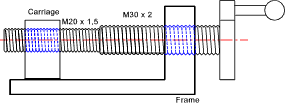




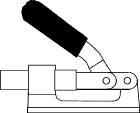
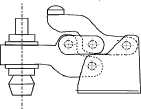




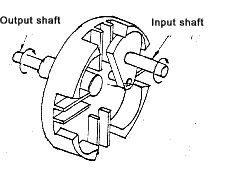
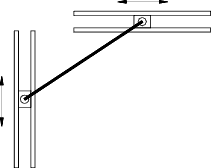
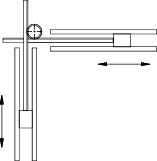
 Whitworth Straight Line Mechanism
Whitworth Straight Line Mechanism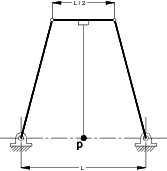 Roberts Straight Line Mechanism
Roberts Straight Line Mechanism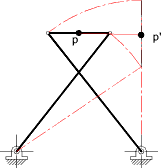 Chebychev Straight Line Mechanism
Chebychev Straight Line Mechanism